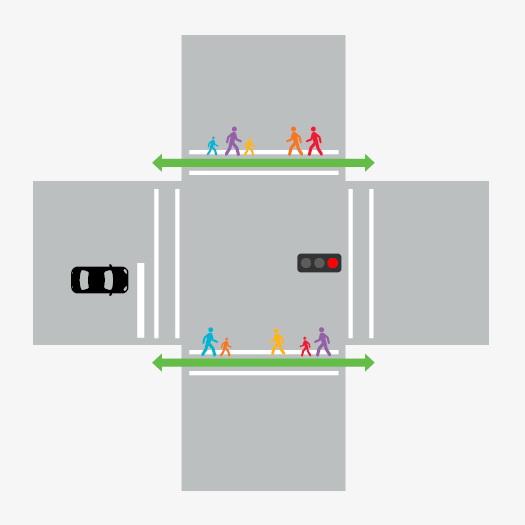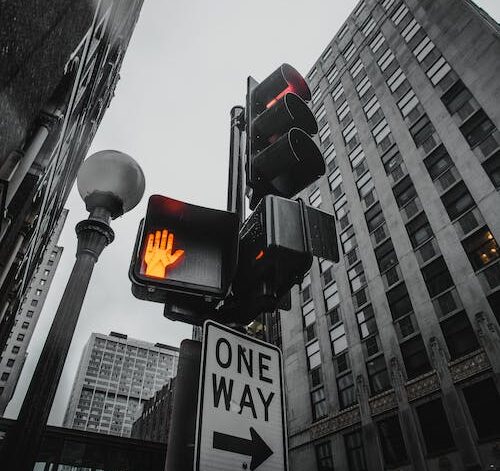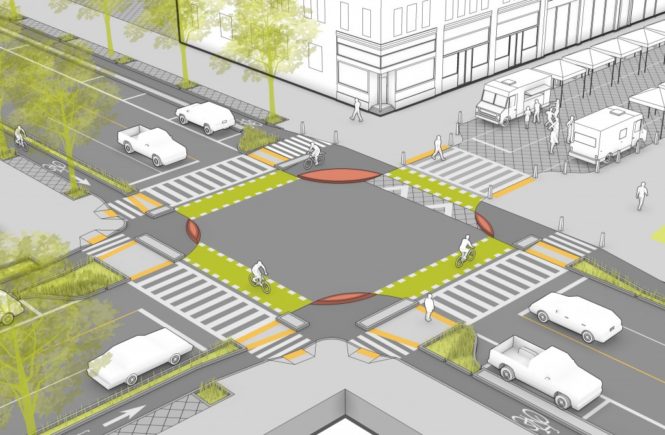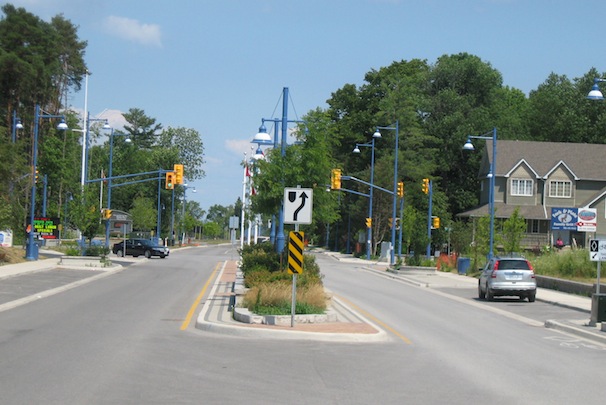Like a lot of safety countermeasures, Leading Pedestrian Intervals (LPIs) have been slow to take off in the U.S. While common in Europe, they’ve only recently been implemented in American cities. LPIs are a short, pedestrian-only signal phase that protects people from turning traffic during a “Walk” signal. The need for LPIs may not be apparent if you mostly drive, but if you’ve walked around urban or suburban areas, you’ve probably had a near-miss with a turning vehicle at an intersection, even if you had a “Walk” sign. Yes, pedestrians have the right-of-way in a crosswalk, and drivers are required to yield to people when making turns in an intersection. But when the traffic light is green on a street parallel to a crosswalk, automobile/pedestrian conflicts naturally occur with turning traffic. In fact, NYC DOT put together a study of just left turning vehicle/pedestrian crashes and found that pedestrians and bicyclists are killed or severely injured (KSI) by a left-turning vehicle at over three times the rate (19%) of right-turning crashes (6%). The vast majority of these KSI crashes involved pedestrians/cyclists crossing while they had a “Walk” signal.

Let’s talk about the pros and cons of LPIs. To play devil’s advocate, I’ll list the major con first and get it out of the way. These are arguments I’ve heard from [redacted] agencies who are still hesitant to try LPIs.
- Impact on Intersection Capacity: LPIs reduce the time available for vehicles to clear intersections during each signal cycle, potentially impacting intersection capacity during peak traffic periods and increasing delay. Keep in mind this is only a few seconds of delay, and signal timing could be rebalanced by extending the cycle length slightly. The fact that cars may need to wait a few more seconds for pedestrians to cross is, in my opinion, a worthwhile trade off to make intersections safer. We also need to think holistically about delay. Pedestrians and cyclists are road users, too, and engineers should take their trip delay into account.
The pros of LPIs:
- Pedestrian Safety: The primary benefit of LPI is improved pedestrian safety. By allowing pedestrians to start crossing before vehicles get a green signal, LPIs increase visibility and reduce the risk of conflicts with turning vehicles. Numerous LPIs have been implemented across the nation with results showing a significant improvement in pedestrian safety. The official pedestrian crash reduction is 13% according to FHWA, but other real-world results have shown a 34% reduction in serious injury and fatal pedestrian crashes. Another study in State College, PA has shown a 58% reduction in pedestrian crashes at treated intersections.
- Reduced Conflicts: LPIs help minimize conflicts between pedestrians and turning vehicles, particularly left-turning vehicles, which might otherwise intersect with pedestrians in crosswalks. Often, drivers try to beat pedestrians in parallel crosswalks so they can make a turn without having to wait for people to cross. This conflict is now eliminated, since the signal clearly assigns right-of-way to the pedestrian. In fact, LPIs can help improve traffic flow since much of the pedestrian traffic in a crosswalk is cleared out during the LPI phase.
- Increased Visibility: This falls under safety, but pedestrians are more visible to drivers when they start crossing before the vehicle signal turns green, reducing the likelihood of collisions.
- Encourages Walking: By making pedestrian crossings safer and more comfortable, LPIs can promote walking as a sustainable and healthy mode of transportation. Even for people who don’t know what LPIs are, they will feel safer at the intersection.
Ideally, LPIs are combined with No Turn on Reds (NTOR) to give added protection to pedestrians. This idea makes some traffic engineers uncomfortable because of capacity issues, but did you know that the U.S. is one of few nations in the world that even allows Turn on Red by default? Our drivers have been excessively coddled at the expense of eroding safety and increasing pedestrian deaths. If NTOR means drivers have to wait a few more seconds so that people have a far lower probability of dying on our streets, I will gladly take that trade off.
NYC, LA and other cities have recently installed LPIs, but the process is often bogged down by needless engineering criteria and bureaucracy, and signal-by-signal rollouts are slow. Yes, standards and formal processes for roadway changes are needed and should be used for many safety devices, but the benefits of LPIs are so great and the costs are so low (often under $1500 per signal) that this is a case where neighborhood or city-wide installations are justified. And that’s exactly what Tampa has done. FDOT’s District 7 has installed 500 LPIs over the past few years, one of the leading State DOTs that is taking pedestrian safety seriously.
Cities are always looking for low cost, high benefit, quick win projects that have a tangible, easily proven safety benefit. There is almost nothing that beats LPIs in this regard, and cities across the U.S. should be rushing to change their signal timing to reap these safety benefits. Pedestrian lives are at stake.
Resources and Research
- Bloomberg: The Incredibly Cheap Street Fix That Saves Lives (Leading Pedestrian Intervals)
- DDOT and VHB presentation on LPI results
- Accident Analysis and Prevention Journal article: Leading pedestrian intervals – Yay or Nay?
- The Urbanist: Bellevue Implements Strategies to Protect People Walking and Rolling Downtown




